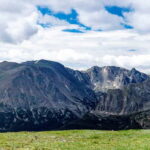National Girlfriends Day
National Raspberry Cream Pie Day
National Day of Switzerland Traditional founding date of Switzerland in 1291; The Old Swiss Confederacy was formed with the signing of the Federal Charter.
August 1, 1620 – The Speedwell left Delfshaven, Netherlands and reached Southampton, Hampshire in southeast England. At Southampton it met up with the Mayflower and set out for America on August 5, 1620. Shortly after the Speedwell started taking on water so the ships landed at Dartmouth, Devon. The leaks were sealed and the ships sailed again. They got as far as Plymouth, Devon when the Speedwell was again leaking. It was decided to sell the Speedwell and transfer the passengers and crew to the Mayflower. Of the combined 121 passengers, 102 were chosen to make the trip. The reduced party finally sailed on Sept 6th.
1790 – The first U.S. census was completed with a total population of 3,929,214 recorded. The areas included were the original thirteen colonies (now states) and Kentucky, Maine, and Tennessee. The population had grown from 350 at Jamestown, Virginia in 1610.
1801 – First Barbary War: The American schooner USS Enterprise captured the Tripolitan corsair Tripoli after a fierce but one-sided battle off the coast of modern-day Libya. Unscathed, Enterprise sent the battered pirate into port since the schooner’s orders prohibited taking prizes. Remembered in Marine hymn “From the halls of Montezuma… to the shores of Tripoli…”
1834 – Slavery was abolished in the British Empire as the Slavery Abolition Act of 1833 went into force.
 Colorado Day, a legal holiday in Colorado in honor of the admission to the Union in 1876 as the thirty-eighth state
Colorado Day, a legal holiday in Colorado in honor of the admission to the Union in 1876 as the thirty-eighth state
- Capital: Denver
- Nickname: Centennial State
- Bird: Lark bunting
- Flower: Rocky Mountain Columbine
- Tree:Blue Spruce
- Motto: Nothing Without Providence
See our page Colorado for more interesting facts and trivia about Colorado.
The first Jeep was produced on August 1, 1941.
1943 – In the Solomon Islands, the U.S. Navy patrol torpedo boat PT-109 sank after being hit by the Japanese destroyer, Amagiri. The boat was under the command of Lt. John F. Kennedy. Eleven of the thirteen crew survived.
August 1, 1944: Anne Frank made the last entry in her diary. Three days later she was arrested. She was deported to Auschwitz on Sept 3, 1944 and died in early March, 1945.
The United States and Canada formed the North American Aerospace Defense Command (NORAD) in 1957.
1961 – U.S. Defense Secretary Robert McNamara ordered the creation of the Defense Intelligence Agency (DIA), the nation’s first centralized military espionage organization. It operates under the jurisdiction of the Dept of Defense.
From Today in Science
In 1831, New London Bridge opened to traffic. In 1821, a committee was formed by Parliament to consider the poor condition of the existing centuries-old bridge. The arches had been badly damaged by the Great Freeze, so it was decided to build a new bridge. Building commenced under John Rennie in 1825, and completed in 1831, at the expense of the city. The bridge is composed of five arches, and built of Dartmoor granite. It was opened with great splendour by King William IV, accompanied by Queen Adelaide, and many of the members of the royal family, August 1st, 1831. In the 1960’s it was auctioned and sold for $2,460,000 to Robert McCulloch who moved it to Havasu City, Arizona. The rebuilt London Bridge was completed and dedicated on 10 Oct 1971.
Also from Today in Science
In 1873, English inventor Andrew Smith Hallidie, in the U.S. since 1852, revolutionized transportation methods in San Francisco when he successfully tested a cable car he had designed to solve the problem of providing mass transit up San Francisco’s steep hills. He not only invented, but also manufactured, and patented the first cable car and its system of wire ropes, pulleys, tracks, and grips that made it possible. Hallidie, an engineer and one-time miner, realized the need on one foggy day in 1869 when he watched in horror as horses pulling a carriage up one of the City’s steep grades slipped on the wet cobblestoned street, the heavy carriage rolled backward downhill and the five horses dragged behind it suffered fatal injuries. Hallidie, using wire rope, had already had much success in the use of cable drawn ore cars for use in mines.
Birthdays
Birthday of William Clark (August 1, 1770), American solider and explorer who, together with Meriwether Lewis, led an expedition from St. Louis to the Pacific following the Louisiana Purchase. Their journey lasted from May 1804 to September 1806.
Birthday of Francis Scott Key (August 1, 1779), American lawyer and author of “The Star-Spangled Banner”.
Birthday of Herman Melville (August 1, 1819), American author of “Moby Dick”
